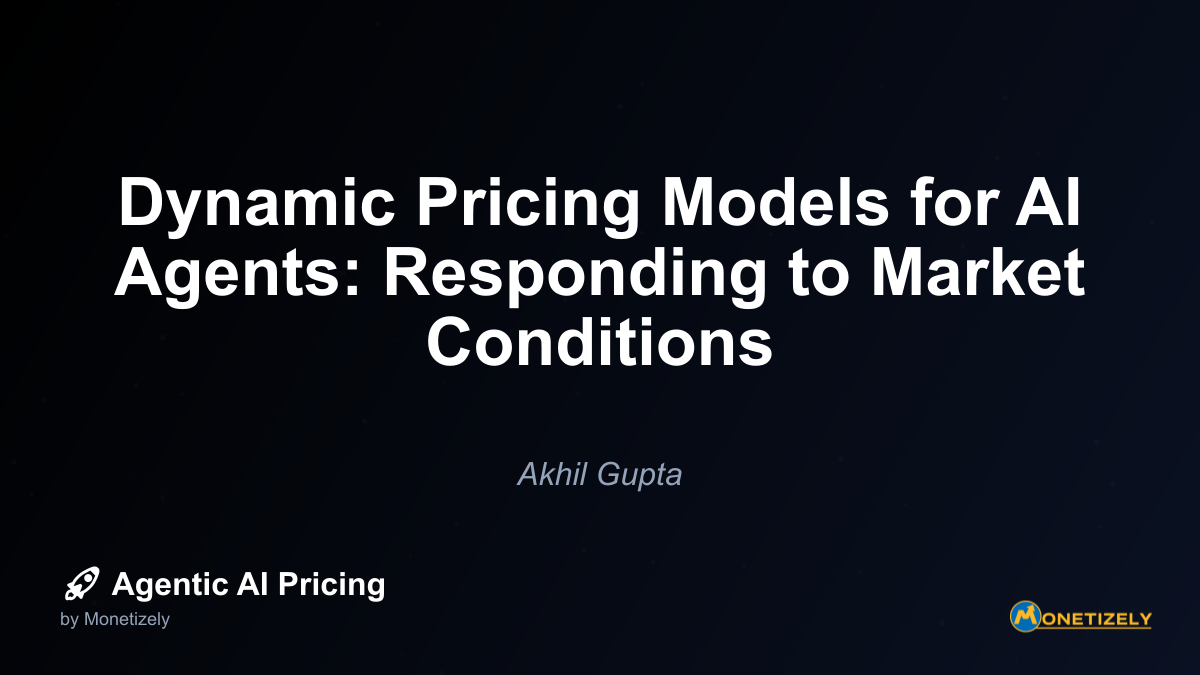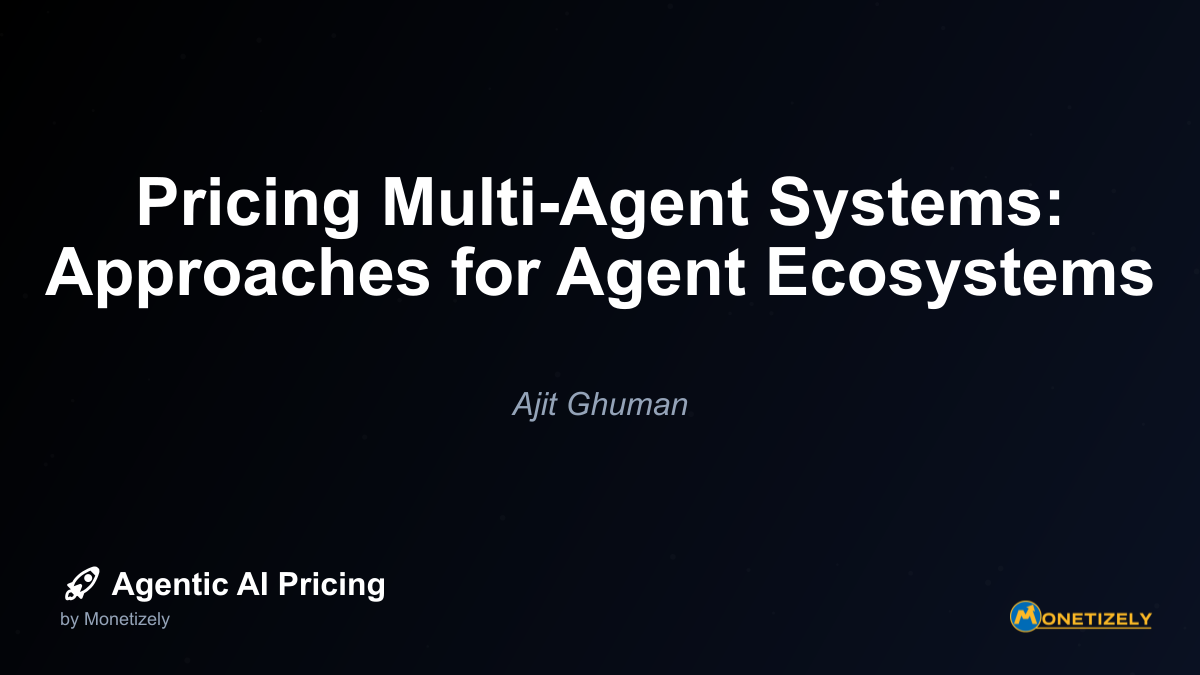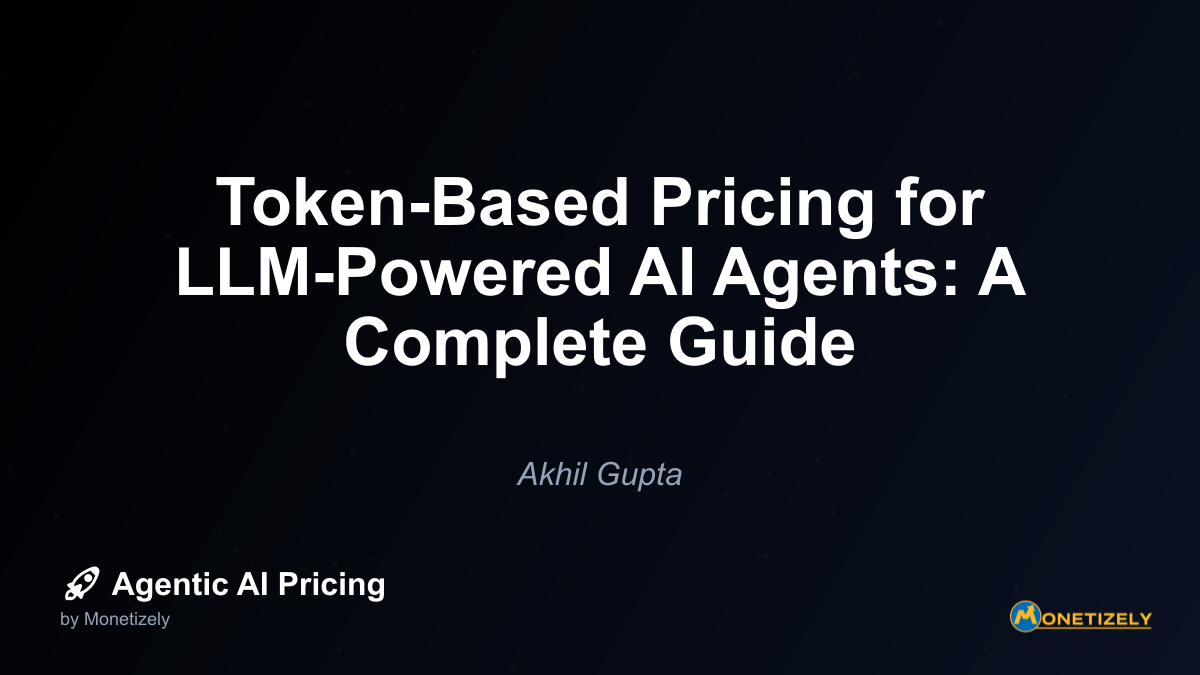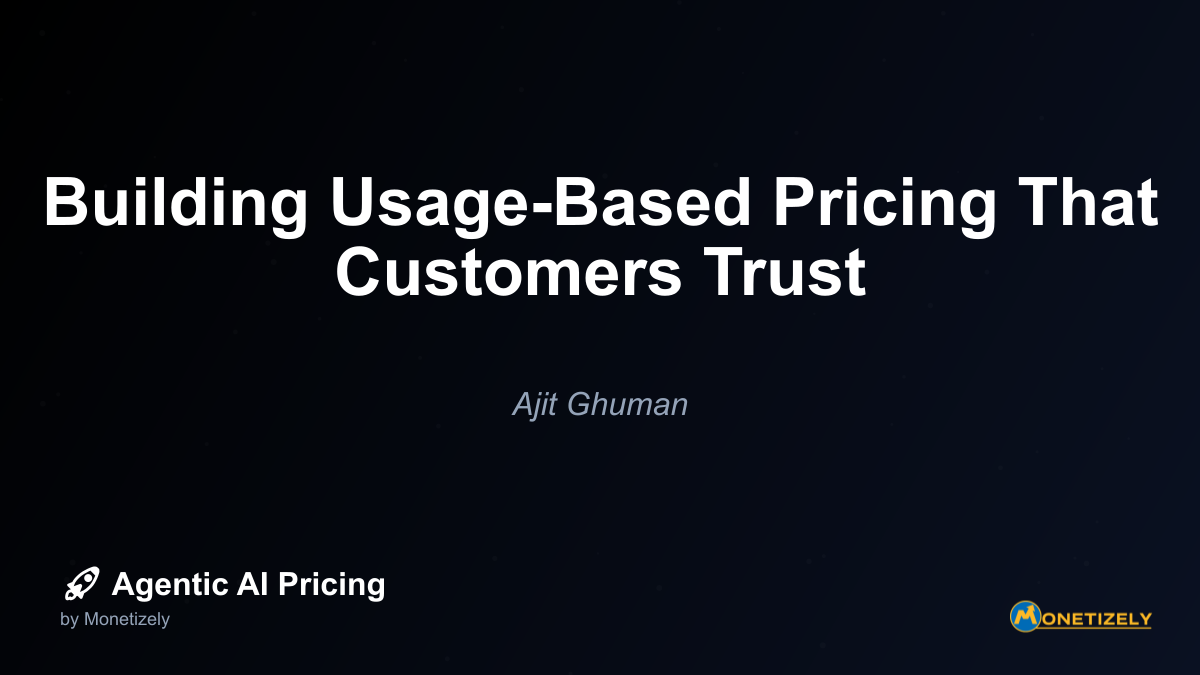· Ajit Ghuman · AI Pricing Models · 13 min read
Freemium Strategies for Agentic AI: When They Work and When They Don't
AI and SaaS Pricing Masterclass
Learn the art of strategic pricing directly from industry experts. Our comprehensive course provides frameworks and methodologies for optimizing your pricing strategy in the evolving AI landscape. Earn a professional certification that can be imported directly to your LinkedIn profile.
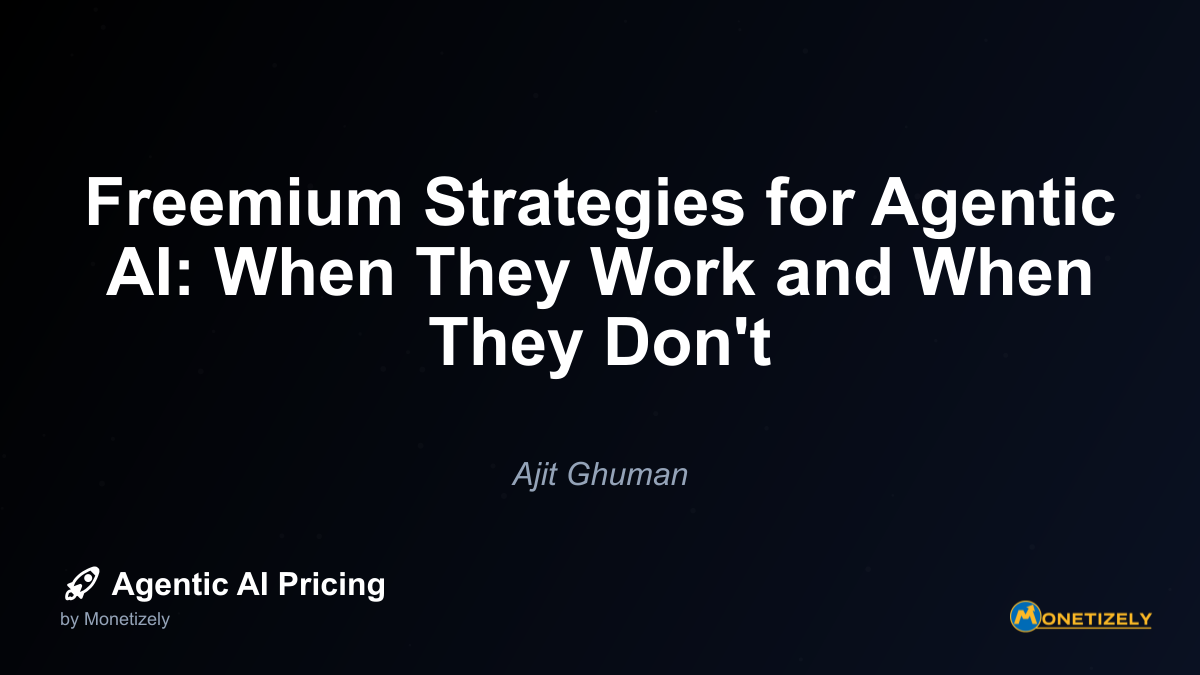
In the rapidly evolving landscape of artificial intelligence, freemium models have emerged as a popular go-to-market strategy for companies deploying AI agents. This approach—offering basic functionality for free while charging for premium features—presents unique opportunities and challenges specific to the AI agent ecosystem. Understanding when freemium strategies work for AI agents and when they don’t is crucial for businesses navigating this complex terrain.
The Economics of Freemium in the AI Agent Ecosystem
Freemium strategies have gained significant traction in the AI agent market, which is experiencing explosive growth. According to recent market analysis, the global AI agents market expanded from approximately $3.66–5.4 billion in 2023–2024 to projections around $7.6 billion in 2025, with forecasts suggesting it will exceed $47 billion by 2030, representing a compound annual growth rate (CAGR) of 44–45%.
This rapid expansion creates fertile ground for freemium models, which typically achieve conversion rates of 8–10% from free to paid users—significantly higher than traditional eCommerce conversion rates of 1–2%. The economic appeal is clear: freemium approaches can lower customer acquisition costs (CAC) by 8% to 50% depending on implementation specifics, with feature-based freemium models showing the most dramatic CAC reductions.
The LTV-CAC Equation for AI Agents
For AI agent providers, the lifetime value (LTV) to customer acquisition cost (CAC) ratio is a critical metric. Industry standards suggest a healthy LTV:CAC ratio of 3:1 or higher ensures sustainable profitability. This ratio becomes particularly important in the AI agent context due to the computational costs associated with running these systems.
Unlike traditional software, AI agents—especially those powered by large language models—incur substantial backend costs with each interaction. These costs can be 10-100x higher than traditional software hosting expenses, making free tiers significantly more expensive to maintain at scale. This economic reality forces companies to carefully consider which features to offer for free and which to reserve for paying customers.
When Freemium Works for AI Agents: Success Patterns
Freemium models for AI agents tend to succeed under specific conditions. Understanding these patterns can help businesses determine if this approach aligns with their product and market.
1. When the Value Proposition Is Immediately Demonstrable
AI agents that deliver immediate, tangible value in their free tier tend to convert users more effectively. When users can quickly experience the agent’s capabilities and understand how it solves their problems, they’re more likely to upgrade for additional functionality.
For example, AI-powered virtual assistants that can resolve basic queries demonstrate value immediately. H&M’s AI shopping assistant resolved 70% of customer queries autonomously and increased conversion rates by 25% during chatbot interactions, showcasing clear ROI through both support cost reduction and revenue increases.
2. When Free and Premium Features Are Strategically Differentiated
Successful freemium AI agent implementations carefully balance what’s offered for free versus what requires payment. The free tier must provide sufficient value to attract and retain users while creating natural incentives to upgrade.
Examples like Grammarly and DeepL illustrate this balance by providing basic AI assistance for free while reserving advanced tools or unlimited usage for paid tiers. The key is ensuring the free version solves enough of the user’s problem to demonstrate value (typically 40-60%) but not so much (80%+) that there’s little incentive to upgrade.
3. When Network Effects or Data Advantages Apply
Freemium models work particularly well for AI agents that benefit from network effects or improve with more data. In these cases, free users contribute value to the overall ecosystem by:
- Providing training data that improves the AI’s capabilities
- Creating content or interactions that benefit paying users
- Expanding the network, making the service more valuable for everyone
Spotify exemplifies this approach, using AI-driven personalization to increase engagement and strategically target high-potential users for conversion from free to premium tiers based on usage analytics.
4. When Infrastructure Costs Are Manageable at Scale
Despite the high computational costs of AI agents, freemium models can work when companies have:
- Efficient infrastructure optimization
- Graduated feature access that limits resource-intensive operations for free users
- Clear usage caps that prevent exploitation of free resources
- Alternative revenue streams to offset free-tier costs
Enterprise AI deployments from companies like OpenAI and Anthropic focus on scalable solutions with iterative improvements and secure deployment. Their models often start with free trial capabilities before transitioning to premium enterprise-level contracts, allowing them to manage infrastructure costs while demonstrating value.
When Freemium Fails for AI Agents: Warning Signs
Not all AI agent applications are suited for freemium models. Several patterns indicate when this approach might be problematic.
1. When Computational Costs Outweigh Acquisition Benefits
The economics of freemium models break down when the cost of serving free users exceeds the value they generate through:
- Potential conversions to paid tiers
- Network effects and ecosystem contributions
- Data generation for AI improvement
- Brand awareness and market positioning
This is a particular challenge for AI agents that perform computationally intensive tasks. Each AI query incurs significant backend costs that scale with usage, creating unpredictability in resource consumption since usage varies by prompt length and interaction complexity.
2. When Free Features Don’t Create Natural Upgrade Paths
Freemium fails when there’s a disconnect between free and premium offerings. This happens when:
- Free features solve too much of the user’s problem (80%+), reducing incentive to upgrade
- Premium features don’t address critical pain points that motivate upgrades
- The value gap between free and paid tiers is unclear or insufficient
- Upgrade friction is too high relative to the perceived benefit
Industry data shows that poorly calibrated tiers can either deter upgrades (if free features are too comprehensive) or drive backlash if free features are downgraded later to force conversions.
3. When Security or Compliance Requirements Are Prohibitive
AI agents often operate on sensitive data and perform autonomous actions, introducing risks of unauthorized access, data leaks, privacy violations, and compliance failures. In highly regulated industries like healthcare, finance, or government, the security and compliance requirements may make freemium models impractical due to:
- Data residency and sovereignty requirements
- Audit and compliance overhead
- Need for end-to-end encryption
- Liability concerns with autonomous agent actions
These factors can make it impossible to offer meaningful free functionality while maintaining necessary security standards.
4. When Target Markets Demand Enterprise-Grade Solutions
Enterprise customers often require comprehensive solutions with guaranteed service levels, dedicated support, and extensive customization. For AI agents targeting these markets, freemium models may:
- Signal insufficient enterprise readiness
- Create perception issues around reliability and support
- Fail to address procurement and compliance requirements
- Complicate sales cycles by creating price anchoring at the low end
In these cases, limited free trials or pilot programs often work better than ongoing freemium access.
Case Studies: Freemium AI Agents in Practice
Examining real-world implementations provides valuable insights into the effectiveness of freemium strategies for AI agents.
OpenAI and Anthropic: Enterprise-Focused Approach
While not strictly freemium in the consumer sense, both OpenAI and Anthropic have adopted tiered approaches that incorporate elements of the freemium playbook for their AI agents:
- Implementation approach: Focus on enterprise AI agent deployments with simple, composable design patterns rather than complex architectures for better production-readiness
- Success metrics: Their AI agents have assisted in automating workflows with high independence, successfully deployed in finance (Morgan Stanley with 98% AI adoption), retail finance (Klarna’s $40 million profit improvement), and banking (BBVA’s nearly 3,000 custom agents in five months)
- Freemium elements: These companies emphasize building scalable enterprise solutions with iterative improvements and secure deployment, often starting with free trial capabilities followed by premium enterprise-level contracts
Their approach demonstrates the value of limited free access to showcase capabilities before transitioning to enterprise pricing models based on usage and scale.
Microsoft and Google: Integration-Based Freemium
Microsoft and Google have integrated AI agent capabilities into their larger cloud and productivity ecosystems, using a form of freemium that leverages their existing platforms:
- Implementation approach: AI capabilities are embedded in large-scale SaaS and cloud services, using tiered pricing to encourage adoption
- Success metrics: While specific metrics aren’t publicly disclosed, both companies have successfully used limited free AI features to drive adoption of premium services
- Freemium elements: AI-powered features in Microsoft 365 and Google Workspace use limited free tiers with options for paid advanced functionality, while Azure OpenAI Service enables enterprise customers to experiment with AI agents under usage limits before converting to paid plans
This approach demonstrates how AI agent capabilities can be strategically integrated into existing product suites as a form of freemium strategy.
Slack: Freemium Success Beyond AI
While not exclusively an AI agent company, Slack’s freemium approach provides valuable lessons that apply to the AI agent ecosystem:
- Implementation approach: Clear feature limitations on free tiers drive users to pay as their needs grow, supported by robust customer success management
- Success metrics: Hundreds of thousands of paid subscriptions, with over 317,000 paid customers and 1,731 customers paying more than $100,000 annually (2023)
- Freemium elements: Free plan with restrictions on message history and integrations, motivating upgrades as usage and dependency increase
Slack’s model demonstrates the importance of creating natural upgrade paths based on increased usage and value—a pattern that translates well to AI agent freemium strategies.
Designing Effective Freemium Strategies for AI Agents
Based on market research and case studies, several key principles emerge for designing effective freemium strategies specifically for AI agents.
1. Strategic Feature Differentiation
The most successful freemium AI implementations carefully segment features between free and paid tiers:
Free Tier Features Should Include:
- Basic functionality that demonstrates core value
- Limited but meaningful interaction capabilities
- Sufficient utility to engage users regularly
- Features with lower computational costs
- Capabilities that generate valuable data or network effects
Premium Tier Features Should Include:
- Advanced capabilities that address critical use cases
- Higher accuracy or quality outputs
- Removed usage limits or quotas
- Integration with enterprise systems
- Enhanced security, compliance, and support
- Customization and training options
This differentiation must be driven by user needs and usage patterns rather than arbitrary distinctions.
2. Usage-Based Constraints
For AI agents, usage constraints are often more effective than feature limitations:
- Token or query limits: Capping the number of interactions or tokens processed
- Throughput throttling: Limiting the rate of requests for free users
- Compute time restrictions: Constraining the computational resources available
- Model quality tiers: Offering access to different model capabilities or sizes
These constraints allow users to experience the full capability set while creating natural upgrade paths as their usage increases.
3. Data Privacy and Security Considerations
AI agents present unique privacy and security challenges that must be addressed in freemium models:
- Data usage transparency: Clear policies on how user data is used for model improvement
- Privacy-preserving features: Premium tiers can offer enhanced privacy guarantees
- Compliance capabilities: Paid tiers can include features required for regulatory compliance
- Security enhancements: Advanced security features as premium offerings
These considerations are particularly important as regulatory frameworks around AI continue to evolve.
4. Conversion Optimization Techniques
Successful freemium AI agent providers employ several techniques to optimize conversion:
- Usage-based prompts: Triggering upgrade suggestions when users approach limits
- Value demonstration: Showcasing premium capabilities through limited previews
- Contextual upgrading: Offering upgrades at moments of high perceived value
- Graduated pricing tiers: Creating multiple entry points for different user segments
- Time-limited trials: Combining freemium with trial access to premium features
These techniques should be data-driven and continuously optimized based on user behavior.
The Future of Freemium for AI Agents
Looking ahead to the next 3-5 years, several trends will shape the evolution of freemium strategies for AI agents.
Emerging Business Models
The traditional freemium model is evolving into more sophisticated approaches:
- Hybrid revenue streams: Blending freemium with AI-driven microtransactions or usage-based pricing
- Dynamic feature allocation: AI agents unlocking premium functionalities based on real-time user behavior and value delivered
- AI-as-a-service layers: Embedded into freemium platforms allowing customization and extensibility by third parties
- Value-based pricing: Moving away from traditional time-based billing to outcome-based models where customers pay for results rather than hours spent
These innovations will create more nuanced approaches that balance accessibility with sustainable economics.
Regulatory Considerations
The regulatory landscape for AI is rapidly evolving, with implications for freemium models:
- Increasing emphasis on AI governance: Ensuring ethical AI behavior, data privacy, and fairness in freemium upselling mechanisms
- Transparency requirements: New regulations may mandate clearer disclosures about AI capabilities and limitations
- Data protection regulations: Evolving requirements will affect how user data is leveraged for personalization and monetization
- Sector-specific compliance: Industry-specific regulations will create additional considerations for freemium implementations
Companies will need to adapt their freemium strategies to comply with these emerging requirements while maintaining effective conversion paths.
Technological Advancements
Several technological trends will influence freemium AI agent strategies:
- Agentic AI and autonomous agents: Moving beyond reactive functions to autonomous, independent decision-making systems capable of planning and executing complex tasks with minimal human input
- AI-powered personalization: Integrating AI-driven behavioral analytics and natural language processing to offer smarter recommendations and more intuitive interactions
- Multi-agent collaboration: Using interconnected AI agents working together on different operational tasks to enhance service efficiency
- Edge computing for AI: Reducing cloud computing costs by processing more AI workloads locally
These advancements will create new opportunities for feature differentiation and value delivery in freemium models.
Strategic Decision Framework: Should You Adopt a Freemium Model?
To determine whether a freemium approach is appropriate for your AI agent, consider the following decision framework:
1. Economic Viability Assessment
Evaluate the fundamental economics of your freemium model:
- Infrastructure costs: Can you sustainably support free users given your computational requirements?
- Conversion potential: Is your expected conversion rate (8-10% benchmark) sufficient to offset free user costs?
- LTV:CAC ratio: Will your model maintain a healthy 3:1 or better ratio?
- Alternative revenue sources: Do you have other ways to monetize free users (e.g., data, partnerships)?
If the economics don’t support sustainable operations, freemium may not be viable regardless of other factors.
2. Value Proposition Analysis
Assess how well your AI agent’s capabilities align with freemium requirements:
- Immediate value demonstration: Can users quickly see the agent’s value in the free tier?
- Natural upgrade paths: Do you have compelling premium features that address critical user needs?
- Network effects: Does your agent become more valuable as more users join the ecosystem?
- Data advantages: Does increased usage improve your AI’s capabilities in meaningful ways?
Strong alignment in these areas suggests freemium may be effective.
3. Market and Competitive Evaluation
Consider your market context and competitive landscape:
- Customer expectations: Is freemium the norm in your market segment?
- Competitive dynamics: Will freemium provide competitive advantage or trigger destructive price competition?
- Enterprise requirements: Do your target customers require enterprise-grade solutions that don’t align with freemium?
- Market education needs: Is your market mature enough to understand your value proposition, or do you need freemium to educate users?
These factors will influence how freemium positioning affects your market perception and competitive stance.
4. Implementation Capability Assessment
Evaluate your organization’s ability to execute a freemium strategy:
- Technical infrastructure: Can you implement and maintain the necessary usage tracking and tier management?
- Support capacity: Can you effectively support a potentially large free user base?
- Analytics capabilities: Do you have the tools to measure and optimize conversion?
- Product development: Can you maintain appropriate feature differentiation over time?
Freemium models require specific organizational capabilities to implement effectively.
Implementing a Freemium Strategy: Best Practices
For companies that determine freemium is appropriate for their AI agent, several best practices can improve implementation success.
1. Start with Clear Success Metrics
Define specific, measurable objectives for your freemium strategy:
- Conversion rate targets (industry benchmark: 8-10%)
- CAC reduction goals (potential: 8-50%)
- Free-to-paid user ratio expectations
- User engagement metrics for free tier
- Revenue per user targets for premium tiers
These metrics should align with your overall business objectives and economic model.
2. Implement Robust Usage Analytics
Detailed analytics are essential for optimizing freemium performance:
- Track user behavior patterns that correlate with conversion
- Monitor resource consumption to manage infrastructure costs
- Identify feature usage that indicates upgrade readiness
- Measure engagement metrics that predict long-term retention
- Analyze conversion funnel to identify and address friction points
These insights will drive continuous improvement of your freemium model.
3. Design for Scalability
AI agent freemium models must scale efficiently:
- Implement infrastructure that can handle unpredictable usage spikes
- Design systems that gracefully degrade under load rather than fail
- Create automated resource allocation based on user tier
- Build efficient caching and optimization for common queries
- Develop clear policies for managing excessive usage by free users
Scalability challenges can quickly undermine freemium economics if not addressed proactively.
Co-Founder & CEO
Ajit is the author of Price To Scale, a top book on SaaS Pricing and is the Founder of Monetizely. Ajit has led and worked in pricing and product marketing at firms like Twilio, Narvar and Medallia. His work has been featured in Forbes and VentureBeat. Ajit regularly consults with software companies from Seed stage to post-IPO on pricing strategy. Ajit is also a highly-rated co-instructor for 'The Art of SaaS Pricing and Monetization' on Maven.
Pricing Strategy Audit
Let our experts analyze your current pricing strategy and identify opportunities for improvement. Our data-driven assessment will help you unlock untapped revenue potential and optimize your AI pricing approach.

